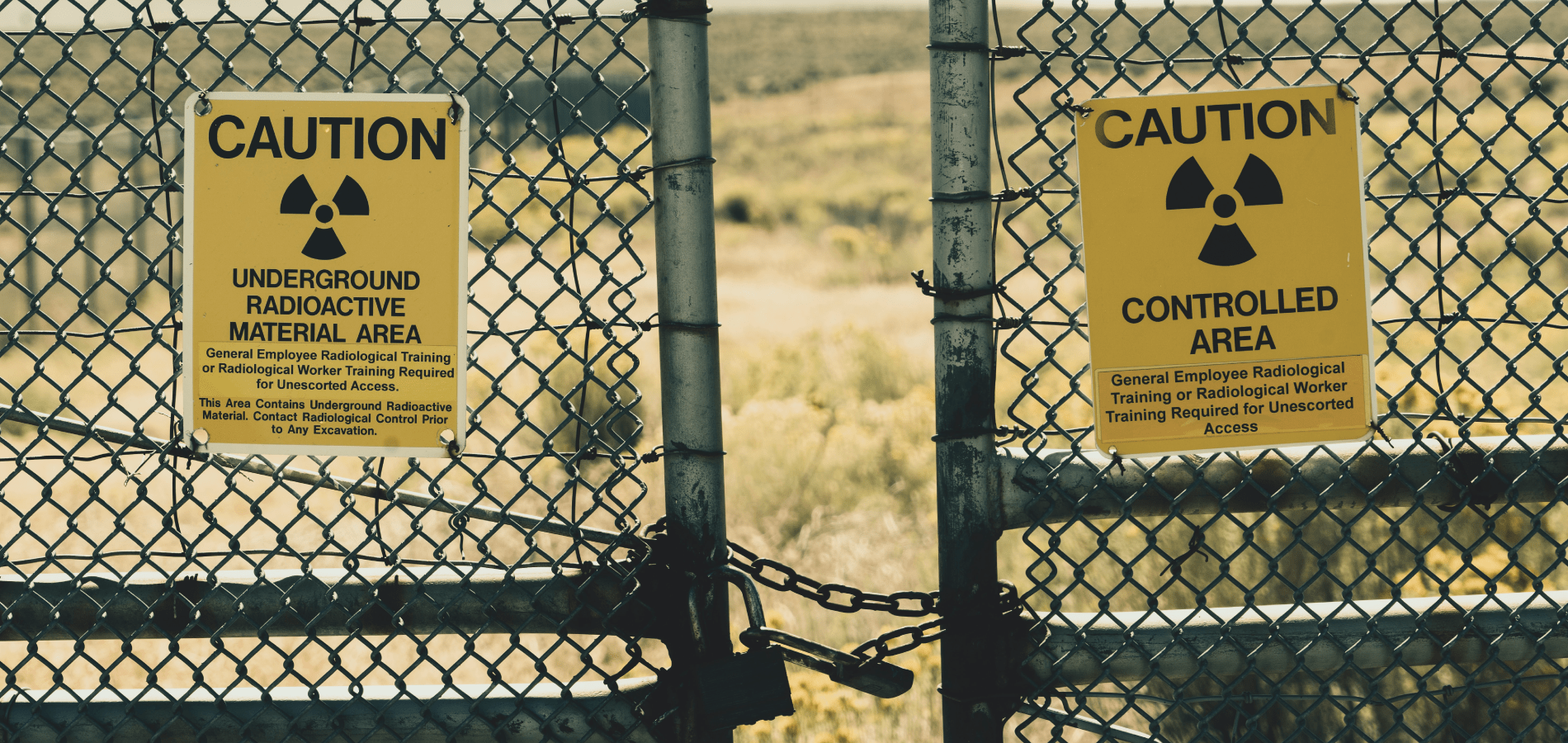We all know the story of the famous sinking of the Titanic, but it was the sinking of a different ship, the U.S.S. Maine, that helped to spur an all-out war between two nations: the United States and Spain. The who, how, and why of the sinking of the Maine remains debated among historians and scientists, but one thing is for sure: it was a catalyst for the Spanish-American war. In this edition of Secrets of the Serial Set, we dive into what happened, and what happened after, using resources from HeinOnline’s U.S. Congressional Serial Set.
The Maine Character
In the mid-to-late-1800s, the United States was far behind in naval advancements compared to the ships being built in Europe. Recognizing that American battleships could not stand up to potential enemies, the U.S. invested in a design for a more updated battleship, developed by naval ship designer and constructor Theodore D. Wilson, in the early 1880s—however, it took nine years to actually build. So by the time the U.S.S. Maine—which weighed more than 6,000 tons and cost more than $2 million—was finally commissioned in the 1890s, more advanced vessels were already available in Europe.
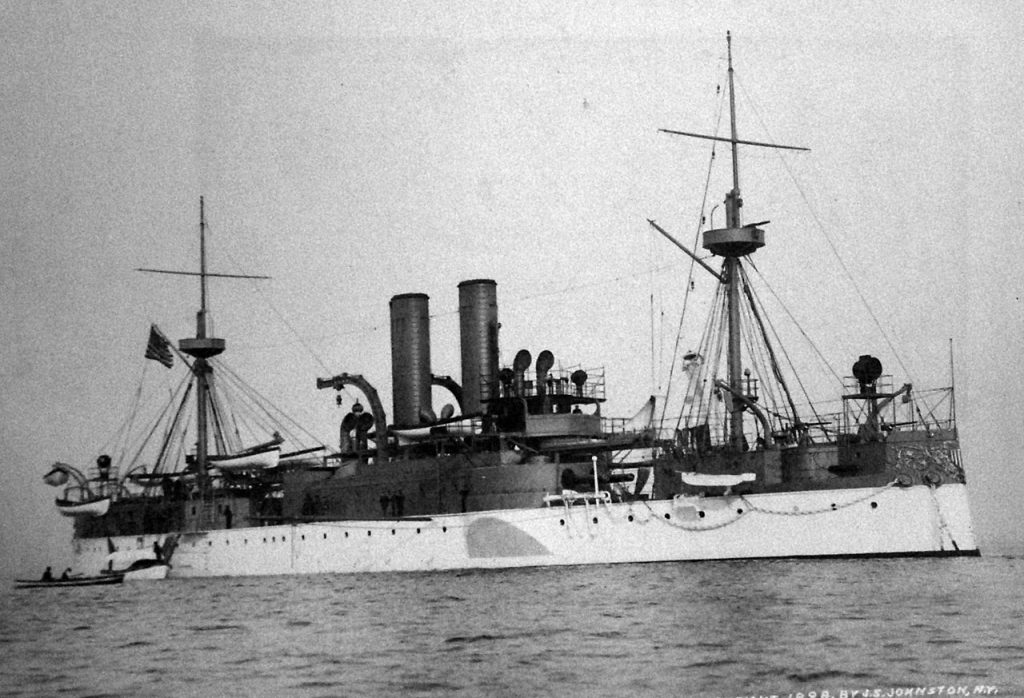
The battleship was sent to the Havana harbor in order to protect American interests during the Cuban uprising against Spanish rule. And on February 15, 1898, at around 9:40 p.m., the Maine suddenly exploded, killing 260 members of the crew,[1]“U.S.S. Maine pension bill.” U.S. Congressional Serial Set, , 1923, pp. 1-2. HeinOnline, https://heinonline.org/HOL/P?h=hein.usccsset/usconset24603&i=52. This document can be found in HeinOnline’s U.S. … Continue reading or about three-quarters of those on board.

Who’s to Blame for the Maine?
A U.S. Navy Court of Inquiry tasked with determining the cause of the explosion found that it was caused by a mine.[2]“Findings, etc., of court of inquiry on destruction of U.S.S. Maine.” U.S. Congressional Serial Set, , 1897, p. 1-308. HeinOnline, https://heinonline.org/HOL/P?h=hein.usccsset/usconset32552&i=5. This document can be … Continue reading However, some Navy officers disagreed, believing that it had resulted from a spontaneous fire within a coal bunker on the ship.

Despite the disagreement, the media immediately blamed the tragedy on Spain. During this time, “yellow journalism”—a sensationalist approach similar to that found in many of today’s tabloids—began to take over the newspaper world, led by William Randolph Hearst of the New York Journal and Joseph Pulitzer of the New York World.[3]“Final report of Select Committee to Study Governmental Operations With Respect to Intelligence Activities 6 pts.” U.S. Congressional Serial Set, , 1976, pp. I-378. HeinOnline, … Continue reading The catchphrase “Remember the Maine!”[4]“Report of commission to investigate conduct of War Dept. in War with Spain, vol. 2: Replies of heads of Departments and correspondence.” U.S. Congressional Serial Set, , 1899, pp. I-1484. HeinOnline, … Continue reading swept over the nation with anti-Spanish sentiment.
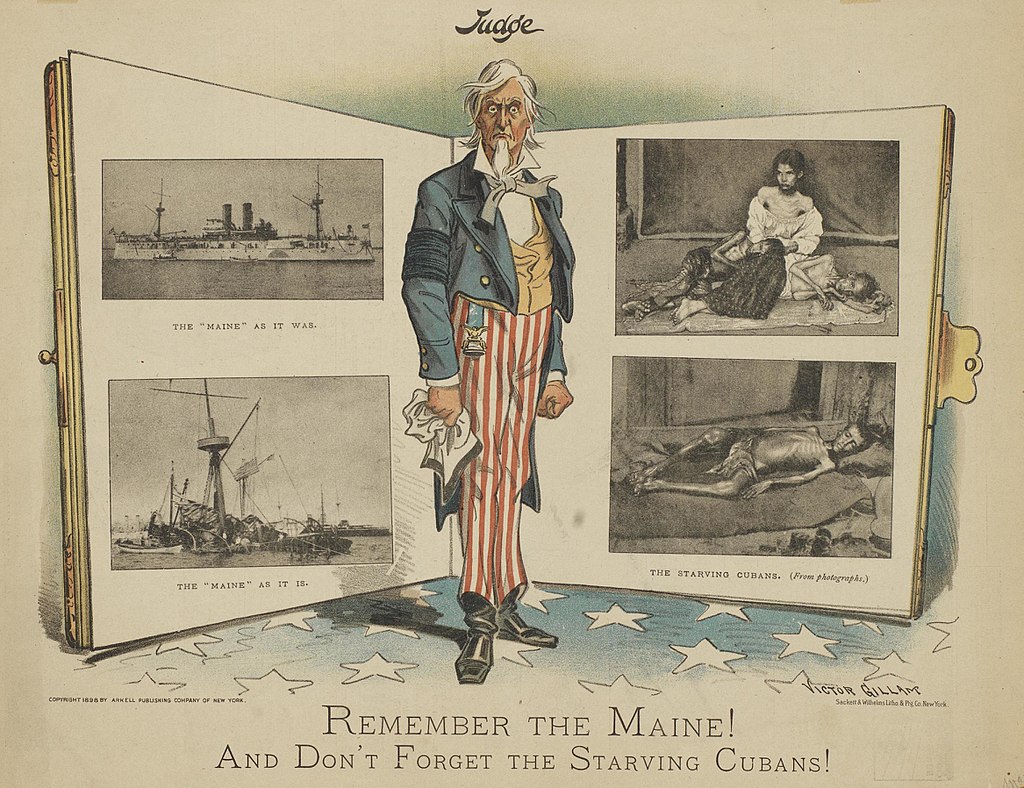
Tensions between the two nations were already high,[5]“Unadjusted difficulties with Spain, with minority report.” U.S. Congressional Serial Set, , 1858, pp. 1-10. HeinOnline, https://heinonline.org/HOL/P?h=hein.usccsset/usconset20105&i=391. This document can be found in … Continue reading with the United States utilizing land in Cuba for sugar. President McKinley faced rampant criticism over his passive approach to Spain—he had called for neutrality in 1895, and hesitated to immediately go to war. But on April 24, the decision was made for him: Spain declared war on the United States. The following day, the U.S. reciprocated and called war on Spain. Thus, the short-lived Spanish-American War began.
The “Splendid Little War”
On May 1, Commodore Dewey led the American fleet to decimate the Spanish in Manila Bay in the Philippines. A month later, Theodore Roosevelt and his volunteer soldiers, the Rough Riders,[6]“Theodore Roosevelt Centennial Commission, compilation of life and career of Theodore Roosevelt.” U.S. Congressional Serial Set, , 1958, pp. I-50. HeinOnline, … Continue reading joined the 10th Cavalry to take the San Juan Heights near Santiago, which subsequently surrendered. American battleships proceeded to take out the Spanish Cuban fleet, and the U.S. took Puerto Rico. In all, more Americans died of disease than from battle during the war. In fact, Secretary of State John Hay even described the conflict as a “splendid little war”[7]“Proceedings of stated convention of 64th national encampment, United Spanish War Veterans, 1962.” U.S. Congressional Serial Set, , 1963, pp. I-161. HeinOnline, … Continue reading—in total it lasted less than eight months. In December, the two nations signed a peace treaty, and Spain handed over the Philippines, Puerto Rico, and Guam to the U.S., while Cuba gained independence.[8]“Legal status of Philippines, Guam, and Porto Rico.” U.S. Congressional Serial Set, , 1899, pp. 1-72. HeinOnline, https://heinonline.org/HOL/P?h=hein.usccsset/usconset31233&i=827. This document can be found in … Continue reading
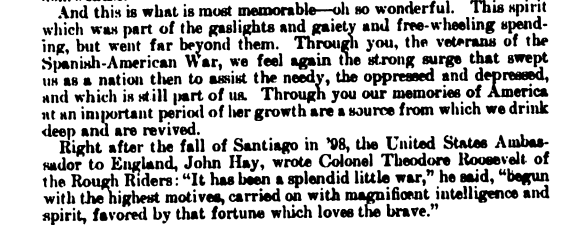
Taking Back the Maine
After the war, the Maine continued to lay at the bottom of the Havana harbor,[9]“Removal of wreck of U.S.S. Maine in Havana Harbor, Cuba.” U.S. Congressional Serial Set, , 1909, pp. 1-4. HeinOnline, https://heinonline.org/HOL/P?h=hein.usccsset/usconset25537&i=149. This document can be found in … Continue reading until a cofferdam was built around it in 1911. The ship was patched up until it was able to float back to the surface, at which point it was taken to sea and sunk yet again. However, the mast now serves as a memorial in Arlington National Cemetery, which is where the bodies remaining in the wreck were interned as well.

In 1976, American naval investigators again tried to determine a definite cause of the explosion on the Maine. Their study found that it was most likely caused by a fire that ignited within its ammunition stocks. However, this is still debated today.
New Feature in the Serial Set
Within HeinOnline’s database version of the Serial Set, users will now find a new green “H” icon located next to some volumes. This icon indicates that the volume solely contains oversized maps and foldouts, which are not currently displayed in HeinOnline. However, users can access a hyperlinked form as this content may be available upon request.
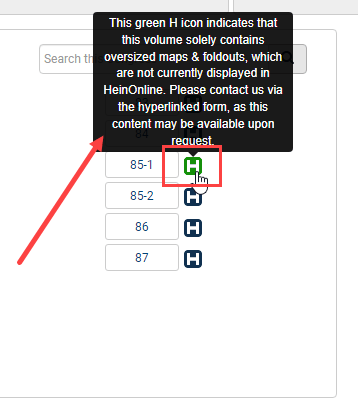
Help Us Complete the Project
Secrets of the Serial Set is an exciting and informative blog series from HeinOnline dedicated to unveiling the wealth of American history found in the United States Congressional Serial Set. Documents from additional HeinOnline databases have been incorporated to supplement research materials for non-U.S. related events discussed.
If your library holds all or part of the Serial Set, and you are willing to assist us, please contact Steve Roses at 716-882-2600 or sroses@wshein.com. HeinOnline would like to give special thanks to all of the libraries that have provided generous contributions which have resulted in the steady growth of HeinOnline’s U.S. Congressional Serial Set.
HeinOnline Sources[+]
| ↑1 | “U.S.S. Maine pension bill.” U.S. Congressional Serial Set, , 1923, pp. 1-2. HeinOnline, https://heinonline.org/HOL/P?h=hein.usccsset/usconset24603&i=52. This document can be found in HeinOnline’s U.S. Congressional Serial Set. |
|---|---|
| ↑2 | “Findings, etc., of court of inquiry on destruction of U.S.S. Maine.” U.S. Congressional Serial Set, , 1897, p. 1-308. HeinOnline, https://heinonline.org/HOL/P?h=hein.usccsset/usconset32552&i=5. This document can be found in HeinOnline’s U.S. Congressional Serial Set. |
| ↑3 | “Final report of Select Committee to Study Governmental Operations With Respect to Intelligence Activities 6 pts.” U.S. Congressional Serial Set, , 1976, pp. I-378. HeinOnline, https://heinonline.org/HOL/P?h=hein.usccsset/usconset21273&i=70. This document can be found in HeinOnline’s U.S. Congressional Serial Set. |
| ↑4 | “Report of commission to investigate conduct of War Dept. in War with Spain, vol. 2: Replies of heads of Departments and correspondence.” U.S. Congressional Serial Set, , 1899, pp. I-1484. HeinOnline, https://heinonline.org/HOL/P?h=hein.usccsset/usconset31235&i=309. This document can be found in HeinOnline’s U.S. Congressional Serial Set. |
| ↑5 | “Unadjusted difficulties with Spain, with minority report.” U.S. Congressional Serial Set, , 1858, pp. 1-10. HeinOnline, https://heinonline.org/HOL/P?h=hein.usccsset/usconset20105&i=391. This document can be found in HeinOnline’s U.S. Congressional Serial Set. |
| ↑6 | “Theodore Roosevelt Centennial Commission, compilation of life and career of Theodore Roosevelt.” U.S. Congressional Serial Set, , 1958, pp. I-50. HeinOnline, https://heinonline.org/HOL/P?h=hein.usccsset/usconset22594&i=126. This document can be found in HeinOnline’s U.S. Congressional Serial Set. |
| ↑7 | “Proceedings of stated convention of 64th national encampment, United Spanish War Veterans, 1962.” U.S. Congressional Serial Set, , 1963, pp. I-161. HeinOnline, https://heinonline.org/HOL/P?h=hein.usccsset/usconset35995&i=77. This document can be found in HeinOnline’s U.S. Congressional Serial Set. |
| ↑8 | “Legal status of Philippines, Guam, and Porto Rico.” U.S. Congressional Serial Set, , 1899, pp. 1-72. HeinOnline, https://heinonline.org/HOL/P?h=hein.usccsset/usconset31233&i=827. This document can be found in HeinOnline’s U.S. Congressional Serial Set. |
| ↑9 | “Removal of wreck of U.S.S. Maine in Havana Harbor, Cuba.” U.S. Congressional Serial Set, , 1909, pp. 1-4. HeinOnline, https://heinonline.org/HOL/P?h=hein.usccsset/usconset25537&i=149. This document can be found in HeinOnline’s U.S. Congressional Serial Set. |

